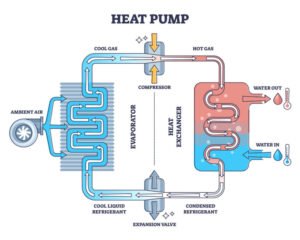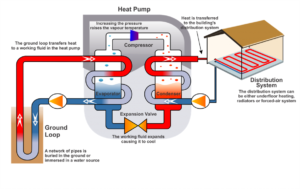Green Building HVAC Systems: Unveiling the Details with Benefits
Types of hvac system in green building prioritize sustainability and energy efficiency, and HVAC systems play a central role in achieving these goals. Here’s a detailed exploration of some common types of HVAC systems ideal for green buildings, along with their benefits:
1. High-Efficiency Air Conditioning Systems:
- Focus: Minimizing energy consumption for cooling. This translates to significant cost savings on your utility bills.
- Key Features:
- SEER Ratings: Look for systems with high SEER (Seasonal Energy Efficiency Ratio) ratings, ideally 18 or higher. The higher the SEER rating, the less energy the system uses to provide the same level of cooling.
- Variable-Speed Compressors: These compressors adjust their output based on cooling needs, unlike traditional on/off systems that waste energy during startup and shutdown.
- Inverter Technology: Inverter technology allows the compressor to run continuously at variable speeds, further improving efficiency.
- Two-Stage Cooling: These systems operate in two stages, providing efficient cooling at low capacity during mild weather and higher capacity during peak cooling periods.
Benefits:
- Reduced energy consumption and operating costs
- Lower environmental impact due to decreased energy use
2. Heat Pumps:
- Dual Functionality: Heat pumps offer both heating and cooling capabilities, eliminating the need for separate systems and potentially reducing overall equipment costs.
- Energy Efficiency:
- HSPF Ratings: Choose models with high HSPF (Heating Seasonal Performance Factor) ratings for efficient heating performance.
- Heat Pump Technology: Heat pumps move heat instead of generating it, resulting in higher efficiency compared to traditional electric resistance heating.

Benefits:
- Reduced energy consumption and operating costs
- Potential for a smaller system footprint by eliminating the need for separate heating and cooling equipment
- More environmentally friendly operation
3. Ground-Source Heat Pumps (GSHPs):
- Geothermal Power: These innovative systems tap into the earth’s constant temperature for highly efficient heating and cooling. They utilize buried loops or wells to exchange heat with the ground.
- Sustainability: GSHPs are a renewable energy source and offer significant energy savings compared to traditional HVAC systems. They can reduce energy consumption for heating and cooling by up to 60%.

Benefits:
- Exceptional energy efficiency, leading to substantial cost savings
- Renewable energy source with a lower environmental impact
- Long lifespan and quiet operation
4. Air Handling Units with Heat Recovery (AHUs with HRV):
- Fresh Air Focus: These units prioritize supplying fresh outdoor air while minimizing energy waste. They are often used in conjunction with other HVAC systems.
- Heat Recovery:
- HRV Technology: An HRV captures heat or coolth from outgoing exhaust air and transfers it to incoming fresh air. This preconditions the incoming air, reducing the energy required to reach the desired temperature.
Benefits:
- Improved indoor air quality by providing a constant supply of fresh air
- Energy savings by preconditioning incoming air with recovered heat or coolth
5. Dedicated Outdoor Air Systems (DOAS):
- Targeted Ventilation: DOAS provide conditioned fresh air directly to specific areas within a building, offering better control and potentially reducing overall energy use compared to traditional mixed air systems that condition all of the supply air.
- Flexibility: DOAS can be integrated with various HVAC systems like heat pumps or boilers to cater to specific building needs. They are often used in buildings with high occupancy levels or where specific areas require controlled ventilation.
Benefits:
- Improved indoor air quality by providing fresh air directly to occupied spaces
- Potential for energy savings by conditioning only the air that is needed
- Flexibility to accommodate varying ventilation needs in different areas of a building
6. Systems with Natural Ventilation Strategies:
-
Harnessing Nature: Green buildings often leverage natural ventilation whenever possible to reduce reliance on mechanical HVAC systems. This can significantly reduce energy consumption, especially in moderate climates.
-
Strategies:
- Operable Windows: Allow for fresh air intake and natural air circulation, improving indoor air quality and occupant comfort.
- Light Shelves: Project sunlight deeper into a space, reducing reliance on artificial lighting and heat gain from electric lights.
- Stack Ventilation: Utilizes temperature differences and natural buoyancy to remove hot air and introduce cooler air, promoting passive cooling.
Benefits:
- Reduced energy consumption by utilizing natural ventilation to cool and ventilate a building
- Improved indoor air quality by introducing fresh air
- Enhanced occupant comfort with natural light and ventilation
Choosing the Right System:
The ideal HVAC system for a green building depends on several factors, including:
- Climate
- Building size and type
- Occupancy levels
- Budget
Consulting with a qualified HVAC professional can help you determine the most suitable
Looking to install a commercial HVAC System or Duct work in your Business Area?
Contact Vipul Ac to learn about our HVAC Service
Call +91 9825636606 Today.
